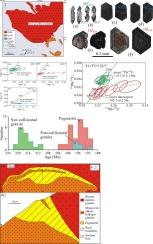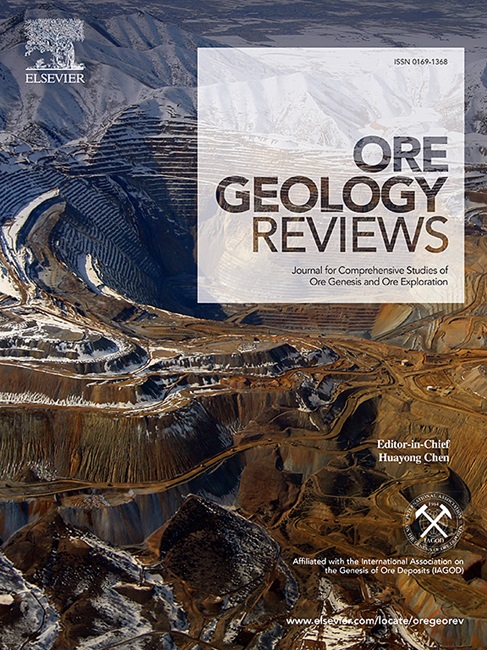关于可可托海 3 号伟晶岩岩体的岩石成因的新见解:来自阿拉尔花岗岩群(中国新疆)的岩石学和锆石学证据
IF 3.2
2区 地球科学
Q1 GEOLOGY
引用次数: 0
摘要
含有大量锂-铍-铌-钽-硒矿产资源的可克托凯三号伟晶岩堤(KPD)是世界上最著名的稀有金属矿床之一,备受关注。迄今为止,有关 KPD 的地质年代数据已报道了三十多个,年代从 332 Ma 到 120 Ma 不等,这导致伟晶岩的起源和成岩过程存在不确定性。在这篇论文中,对阿拉尔生物橄榄岩单斜长花岗岩(BMG)、Koktokay蕈云母碱长石花岗岩(MAG)和 KPD 进行了全岩地球化学和锆石地质年代研究。岩石学和全岩地球化学研究结果表明,BMG 属于正常花岗岩,二氧化硅含量中等(平均为 67.23%),富含钡、锶和锆等相容微量元素,Eu 负异常轻微;而 MAG 属于高分化花岗岩,二氧化硅含量高(平均为 73.锆石形态和 LA-ICPMS 分析显示,BMG 的岩浆锆石、MAG 和 KPD 的热液锆石的截距年龄较低,分别为 217.3 ± 2.4 Ma、197.8 ± 4.7 Ma 和 195.4 ± 2.0 Ma。结合阿勒泰地区花岗岩活动及其成矿作用的构造信息和地质年代数据,本研究解释了KPD在Wang等(2021)的成矿机制之后的成岩机制。(2021) 的成矿模型解释了 KPD 的成岩机制:(1)在中三叠世晚期,西伯利亚板块与哈萨克斯坦-准噶尔板块碰撞,造成阿勒泰造山带大量推覆断裂和地壳增厚;在 ∼217 Ma 时,压缩达到顶峰,地壳膨胀产生了同步碰撞型 BMG(即阿拉尔 BMG);在 ∼217 Ma 时,地壳压缩达到顶峰,地壳膨胀产生了同步碰撞型 BMG(即阿拉尔 BMG);在 ∼217 Ma 时,地壳压缩达到顶峰,地壳膨胀产生了同步碰撞型 BMG(即阿拉尔 BMG)、在压缩峰值之后,深部岩浆腔中的大量花岗岩岩浆经历了 20 多万年的碎裂结晶,岩浆腔顶部出现了富含成矿物质(稀有金属元素、挥发性成分和水液)的残余岩浆;(2) 当区域应力由压缩转为伸展时,高度分馏的残余岩浆在195 Ma∼迅速从长寿命岩浆室沿伸展断层上升;残余岩浆在喷出过程中,由于压力急剧下降,大量含熔流体从残余岩浆中喷出,侵入到延伸断层产生的大空洞中;随着温度的缓慢降低,富集的熔融流体由外向内结晶为(准)同心辉长岩带(即 "辉绿岩带")。e.,KPD);(3)失去大量流体的残余岩浆充满了伸展系统的下部空间,并结晶为碰撞后 MAG(即 Koktokay MAG)。根据构造、岩石成因和金属成因之间的遗传关系,所提出的模型显示了从同步碰撞花岗岩到后碰撞花岗岩与花岗-伟晶岩沉积的物质和能量转换过程。本文章由计算机程序翻译,如有差异,请以英文原文为准。

New insights on the petrogenesis of the Koktokay No.3 pegmatitic dyke: Petrological and zirconological evidence from the Aral granitic complex (Xinjiang, China)
The Koktokay No.3 pegmatite dyke (KPD), containing numerous Li–Be–Nb–Ta–Cs mineral resources, is among the world’s most famous rare-metal deposits, and attracted much attention. Up to now, over thirty geochronological data have been reported ranging from 332 Ma to 120 Ma for the KPD, which causes uncertainty about the origin and petrogenesis of the pegmatite. In this contribution, whole-rock geochemistry and zircon geochronology have been conducted on the Aral biotite monzogranite (BMG), the Koktokay muscovite alkali-feldspar granite (MAG), and the KPD. Petrological and whole-rock geochemistry results reveal that the BMG is normal granite with medium SiO2 (mean of 67.23 %), enriched in compatible trace elements such as Ba, Sr and Zr, and slight negative Eu anomalies, while the MAG belongs to highly-fractionated granite with high SiO2 (mean of 73.92 %) and extensive negative Eu anomalies, and enriched in incompatible trace elements such as Rb, Ta, and U. Zircon morphology and LA–ICPMS analysis reveal that magmatic zircons from the BMG, hydrothermal zircons from the MAG and KPD yield lower intercept ages at 217.3 ± 2.4 Ma, 197.8 ± 4.7 Ma, and 195.4 ± 2.0 Ma, respectively. Combining with tectonic information and geochronological data of granitic activity and its mineralization in the Altay, this study explains the petrogenetic mechanism of the KPD after Wang et al. (2021)‘s metallogenic model: (1) In late stage of Middle Triassic, the collision between the Siberian plate and the Kazakhstan–Junggar plate caused a large number of thrust nappe faults and crust thickening in the Altay orogenic belt; At ∼217 Ma, the compression reached its peak, the crustal anatexis produced syn-collisional BMG (i.e., the Aral BMG); After the compressive peak, huge amount of granitic magma in deep-seated magma chamber underwent over 20 Myr of fractional crystallization, and the residual magma enriched in ore-forming materials (rare metal elements, volatile components, and aqueous fluids) occurred at the top of the magma chamber; (2) When the regional stress converted from compression to extension, the highly-fractionated residual magma ascended rapidly from the long-lived magma chamber along extensional faults at ∼195 Ma; The huge amount of melt-bearing fluids were exsolved from the residual magma in the course of its emplacement due to sharply decreasing pressure, and intruded into a large cavity generated by extensional fault; Along with slowly decreasing temperature, the melt-enriched fluids crystallized outside-in as (quasi-) concentric pegmatitic zones (i.e., KPD); (3) The residual magma which lost huge amount of fluid filled the lower space of the extensional system, and crystallized as post-collisional MAG (i.e., the Koktokay MAG). Based on the genetic relationship among tectonics, petrogenesis, and metallogeny, the proposed model shows material and energetic conversion processes from syn-collisional granites to post-collisional granites with granitic–pegmatitic deposits.
求助全文
通过发布文献求助,成功后即可免费获取论文全文。
去求助
来源期刊

Ore Geology Reviews
地学-地质学
CiteScore
6.50
自引率
27.30%
发文量
546
审稿时长
22.9 weeks
期刊介绍:
Ore Geology Reviews aims to familiarize all earth scientists with recent advances in a number of interconnected disciplines related to the study of, and search for, ore deposits. The reviews range from brief to longer contributions, but the journal preferentially publishes manuscripts that fill the niche between the commonly shorter journal articles and the comprehensive book coverages, and thus has a special appeal to many authors and readers.
 求助内容:
求助内容: 应助结果提醒方式:
应助结果提醒方式:


